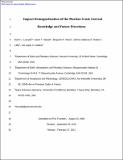Impact demagnetization of the Martian crust: Current knowledge and future directions
Author(s)
Louzada, Karin L.; Stewart, Sarah T.; Gattacceca, Jérôme; Lillis, Robert J.; Halekas, Jasper S.; Weiss, Benjamin P.; ... Show more Show less
DownloadLouzada_2011_open_access.pdf (2.629Mb)
PUBLISHER_CC
Publisher with Creative Commons License
Creative Commons Attribution
Terms of use
Metadata
Show full item recordAbstract
The paleomagnetism of the Martian crust has important implications for the history of the dynamo, the intensity of the ancient magnetic field, and the composition of the crust. Modification of crustal magnetization by impact cratering is evident from the observed lack of a measurable crustal field (at spacecraft altitude) within the youngest large impact basins (e.g., Hellas, Argyre and Isidis). It is hoped that comparisons of the magnetic intensity over impact structures, forward modeling of subsurface magnetization, and experimental results of pressure-induced demagnetization of rocks and minerals will provide constraints on the primary magnetic mineralogy in the Martian crust. Such an effort requires: (i) accurate knowledge of the spatial distribution of the shock pressures around impact basins, (ii) crustal magnetic intensity maps of adequate resolution over impact structures, and (iii) determination of demagnetization properties for individual rocks and minerals under compression. In this work, we evaluate the current understanding of these three conditions and compile the available experimental pressure demagnetization data on samples bearing (titano-) magnetite, (titano-) hematite, and pyrrhotite. We find that all samples demagnetize substantially at pressures of a few GPa and that the available data support significant modification of the crustal magnetic field from both large and small impact events. However, the amount of demagnetization with applied pressure does not vary significantly among the possible carrier phases. Therefore, the presence of individual mineral phases on Mars cannot be determined from azimuthally averaged demagnetization profiles over impact basins at present. The identification of magnetic mineralogy on Mars will require more data on pressure demagnetization of thermoremanent magnetization and forward modeling of the crustal field subject to a range of plausible initial field and demagnetization patterns.
Date issued
2011-04Department
Massachusetts Institute of Technology. Department of Earth, Atmospheric, and Planetary SciencesJournal
Earth and Planetary Science Letters
Publisher
Elsevier
Citation
Louzada, Karin L.; Stewart, Sarah T.; Weiss, Benjamin P.; Gattacceca, Jérôme; Lillis, Robert J. and Halekas, Jasper S. “Impact Demagnetization of the Martian Crust: Current Knowledge and Future Directions.” Earth and Planetary Science Letters 305, no. 3–4 (May 2011): 257–269. © 2011 Elsevier B.V.
Version: Author's final manuscript
ISSN
0012-821X